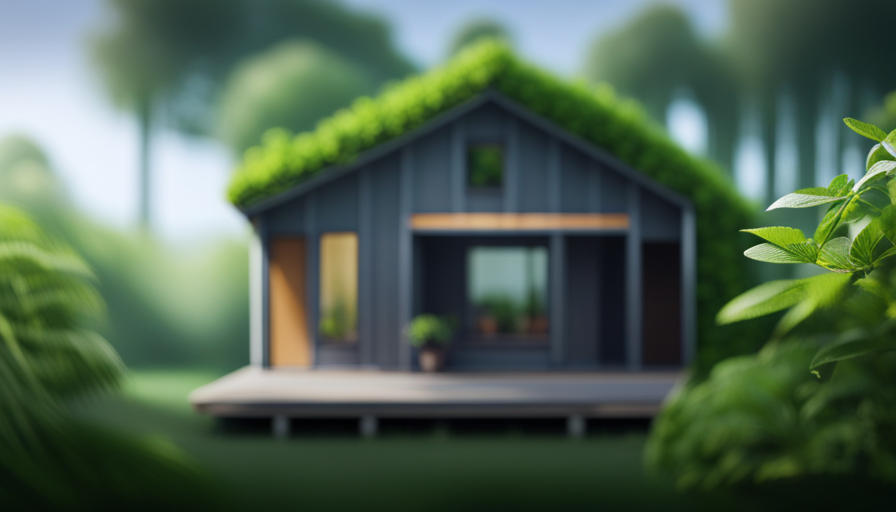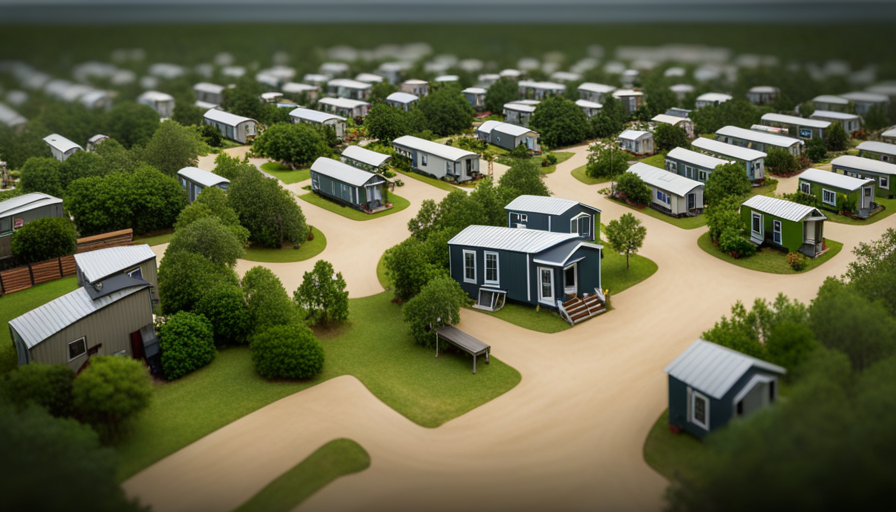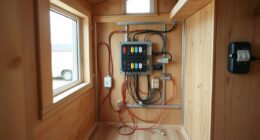Did you know that windows could make up to 15% of the total square footage of a tiny house? This accounts for a significant amount of space dedicated to letting in natural light and creating a sense of openness in these compact living spaces.
When it comes to choosing the size of windows for a tiny house, several factors need to be considered. In this article, I will explore the common window sizes for tiny houses, ways to maximize natural light, and how to balance privacy and views. I will also discuss important safety considerations and provide insights into different window styles and designs.
Whether you are building or renovating a tiny house, choosing the right window size is crucial for creating a functional and visually appealing space. So, let’s dive in and discover the world of windows in tiny houses!
Key Takeaways
- Windows can make up to 15% of the total square footage in a tiny house.
- Common window sizes for tiny houses range from 24×24 to 36×36 inches.
- Popular window options for maximizing natural light in tiny houses include casement windows, awning windows, and picture windows.
- Balancing privacy and views can be achieved through window coverings such as blinds, curtains, or frosted glass.
Factors to Consider When Choosing Window Size
When choosing window size for your tiny house, you’ll want to consider factors such as the amount of natural light you desire and the overall aesthetic you’re aiming for. Maximizing ventilation and energy efficiency are also important considerations.
The size of your windows can greatly impact the amount of natural light that enters your space. Larger windows will allow more light to filter in, creating a bright and airy feel. However, larger windows may also result in more heat loss during the colder months, so it’s important to choose windows with good insulation properties.
Additionally, you’ll want to consider the overall aesthetic of your tiny house. Smaller windows can give your home a cozy and intimate feel, while larger windows can make the space feel more open and spacious.
Transitioning into the subsequent section about common window sizes for tiny houses, it’s important to find a balance between natural light, ventilation, energy efficiency, and the overall look and feel of your tiny home.
Common Window Sizes for Tiny Houses
If you’re planning to build a small home, you’ll be amazed by the average size of windows commonly found in these cozy dwellings. Tiny houses often feature windows that are smaller than those in traditional homes, but they still provide ample natural light and enhance the overall aesthetic appeal.
The most common window sizes for tiny houses range from 24 inches by 24 inches to 36 inches by 36 inches. These sizes are popular because they strike a balance between maximizing natural light and maintaining structural integrity.
When choosing window styles and designs for your tiny house, consider options like casement windows, awning windows, or picture windows to maximize natural light and create a visually pleasing space. By carefully selecting the right window sizes and styles, you can create a bright and inviting atmosphere in your tiny house, making it feel more spacious than it actually is.
Transitioning to the next section, let’s explore some strategies for maximizing natural light without compromising privacy.
Maximizing Natural Light
To truly enhance the ambiance and create a sense of openness, it’s important to strategically harness the power of natural light in your compact living space. Maximizing natural light can make your tiny house feel larger and more inviting.
Here are five ways to achieve this:
- Consider the orientation of your windows to ensure maximum sunlight exposure throughout the day.
- Use lighter paint colors on walls and ceilings to reflect and amplify natural light.
- Opt for larger windows or install skylights to bring in more light.
- Avoid obstructing the windows with furniture or curtains that block sunlight.
- Use mirrors strategically to bounce light around the room and create the illusion of a larger space.
By carefully planning your window placement and utilizing these tips, you can make the most of natural light in your tiny house. Balancing privacy and views is the next important aspect to consider.
Balancing Privacy and Views
When it comes to balancing privacy and views in a tiny house, there are several options for window coverings that can provide the necessary privacy while still allowing for a view of the outside.
Some popular types of window coverings for privacy include blinds, curtains, and frosted or privacy glass. Additionally, there are creative solutions available that can help maintain views while preserving privacy, such as using sheer curtains or installing window film that allows for one-way visibility.
It’s important to consider both functionality and aesthetics when choosing window coverings in order to create a comfortable and practical living space.
Types of window coverings for privacy
Window coverings in a tiny house add a touch of coziness and ensure privacy, making it feel like a true home. When it comes to choosing window coverings, it’s important to find a balance between maximizing natural light and maintaining privacy. There are various types of window coverings that can achieve this balance.
Here is a table showcasing three popular options:
| Window Covering | Pros | Cons |
|---|---|---|
| Blinds | Allow for adjustable privacy | Can be difficult to clean and may block some light |
| Curtains | Offer a soft and elegant look | Require more space to install and can block light |
| Frosted Glass | Provide privacy while letting in light | Limits visibility and can be expensive |
By considering these options, you can find the perfect window coverings that suit your needs in terms of privacy and natural light. In the next section, we will explore creative solutions for maintaining views while preserving privacy.
Creative solutions for maintaining views while preserving privacy
When it comes to window coverings for privacy in a tiny house, there are numerous options available. From curtains and blinds to frosted glass and window films, you can choose the solution that best fits your needs and style.
However, if you also want to maintain your views while preserving privacy, there are some creative solutions to consider. One possibility is using sheer curtains that allow light to filter through while still providing a level of privacy. Another option is installing window shutters that can be adjusted to control both light and privacy. Additionally, choosing the right window styles and designs can help maximize natural light while ensuring privacy. For instance, installing larger windows or adding skylights can bring in more sunlight while maintaining your privacy.
As we move forward, let’s explore some important safety considerations to keep in mind when designing your tiny house.
Safety Considerations
When it comes to safety in a tiny house, two key points to consider are emergency exits and egress requirements, as well as security measures for windows.
It is crucial to have a clear plan for emergency situations, ensuring that there are accessible and properly sized exits to allow for a quick escape.
Additionally, implementing security measures for windows, such as sturdy locks and shatter-resistant glass, can help prevent break-ins and provide peace of mind.
By addressing these safety considerations, we can ensure a secure and protected living environment in a tiny house.
Emergency exits and egress requirements
To ensure your safety, it’s important to consider the size of emergency exits and meet the egress requirements in your tiny house. When it comes to window size regulations, there are a few key things to keep in mind:
-
Adequate size: Emergency exits should be large enough for a person to easily crawl through. Check your local building codes for specific requirements.
-
Accessibility: Make sure emergency exits are easily accessible and not obstructed by furniture or other objects.
-
Visibility: Consider using windows that provide ample natural light and clear views to help in emergency situations.
-
Security: While it’s important to have emergency exits, it’s also crucial to ensure they’re secure to prevent unauthorized access.
By following these guidelines, you can ensure that your tiny house meets the necessary safety standards for emergency exits.
Now let’s discuss the security measures for windows in a tiny house.
Security measures for windows in a tiny house
Implementing proper security measures for the windows in a compact dwelling is essential to ensure the safety and protection of its occupants. In a tiny house, where space is limited, it is crucial to maximize security features without compromising aesthetics or functionality. Regular window maintenance is also important to keep the windows in good condition and prevent any vulnerabilities. Here is a table showcasing three effective security measures for tiny house windows:
| Security Measure | Description | Benefits |
|---|---|---|
| Window Alarms | These devices emit a loud sound when the window is opened or tampered with, alerting the occupants and deterring intruders. | Increased security and peace of mind. |
| Reinforced Glass | Utilizing laminated or tempered glass can make it more difficult for burglars to break into the house through the windows. | Enhanced resistance against forced entry. |
| Window Locks | Installing sturdy locks on the windows adds an extra layer of protection, preventing unauthorized access. | Improved security and control over who can enter the house. |
In addition to these security measures, regular window maintenance, such as cleaning and inspecting for any damage or wear, is essential to ensure their effectiveness. With proper security measures in place, we can now explore different window styles and designs for a tiny house.
Window Styles and Designs
One popular window style in tiny houses is the casement window, which opens like a door and provides a breath of fresh air just like opening a window to new possibilities in life. This style offers several advantages for tiny house owners.
Firstly, casement windows can be strategically placed to maximize natural light and airflow, making the tiny space feel more open and spacious. Secondly, they’re known for their energy efficiency, preventing drafts and reducing heating and cooling costs. Lastly, casement windows are easy to operate and maintain, making them a practical choice for tiny house living.
When it comes to window styles and designs in tiny houses, there are other options to consider as well. Some popular choices include sliding windows, awning windows, and picture windows. Sliding windows are great for maximizing views and natural light, while awning windows can be opened even during light rain showers. Picture windows, on the other hand, provide a stunning focal point and allow for unobstructed views of the surroundings.
Considering the importance of window placement and energy efficiency in a tiny house, it’s crucial to seek professional advice and guidance. They can provide valuable insights into the best window styles and designs that suit your specific needs and preferences.
Professional Advice and Guidance
When it comes to designing and building a tiny house, seeking professional advice and guidance is crucial. Consulting with a tiny house builder or designer can provide valuable insights and expertise on optimizing space, choosing the right materials, and ensuring structural integrity.
Additionally, seeking input from experienced tiny house owners can offer practical advice and lessons learned from their own experiences.
Lastly, it’s essential to consider local building codes and regulations to ensure that your tiny house is in compliance and to avoid any potential legal issues down the line.
By taking these steps, you can ensure that your tiny house project is well-informed and successful.
Consulting with a tiny house builder or designer
Collaborating with a tiny house builder or designer will help you envision the ideal size of windows for your tiny house, making it feel spacious and filled with natural light. Balancing natural light and maximizing privacy are key considerations when determining window size in a tiny house. A professional can provide valuable insights and expertise to help you strike the right balance.
During consultations, a tiny house builder or designer will take into account your preferences and the layout of your tiny house. They can offer recommendations based on their experience and knowledge of tiny house design principles. To give you an idea of possible window sizes, here is a comparison of three common window dimensions:
| Window Size | Width | Height |
|---|---|---|
| Small | 24 in | 36 in |
| Medium | 36 in | 48 in |
| Large | 48 in | 60 in |
By collaborating with a professional, you can ensure that the size and placement of your windows enhance both the functionality and aesthetics of your tiny house. Seeking input from experienced tiny house owners can further inform your decision-making process.
Seeking input from experienced tiny house owners
Seeking advice from seasoned tiny homeowners can provide valuable insights into optimizing the layout and design of your compact abode. When it comes to maximizing space in a tiny house, experienced owners have plenty of tips and tricks up their sleeves. Here are three key insights to consider:
-
Utilize multifunctional furniture: Investing in furniture that serves multiple purposes can help you make the most of every square inch. Look for items like beds with built-in storage or tables that can be folded away when not in use.
-
Consider different insulation options: Proper insulation is essential for maintaining a comfortable living environment in a tiny house. Explore options like spray foam insulation or insulated panels to ensure maximum efficiency and temperature control.
-
Don’t forget about natural light: Windows not only provide a view to the outside world but also make your tiny house feel more spacious. Strategically placing windows throughout your home can create an illusion of openness and help bring in natural light.
Considering local building codes and regulations is crucial when designing your tiny house to ensure compliance and avoid any legal issues. Transitioning into this next section, it’s important to understand the rules that govern the construction of your compact dwelling.
Considering local building codes and regulations
To ensure your compact abode meets all the necessary requirements, it’s crucial for you to take into account the local building codes and regulations in your area.
When it comes to windows in a tiny house, it’s important to consider energy efficiency and explore alternative window options. Many building codes have specific requirements for the minimum size and placement of windows, ensuring safety and emergency escape routes.
However, there is still room for creativity and innovation. I recommend researching energy-efficient window options such as double or triple-pane windows, low-emissivity coatings, or insulated frames. These options can help regulate the temperature inside your tiny house, reducing energy consumption and costs.
Additionally, consider the placement of windows to maximize natural light and airflow, as this can make a significant difference in the overall comfort and livability of your tiny home.
Frequently Asked Questions
Can I install larger windows in my tiny house to maximize natural light?
To maximize natural light in my tiny house, I can definitely install larger windows. By incorporating skylights, I can bring in even more sunlight from above. Another option is using reflective window film, which helps to bounce light around the space.
It’s important to consider the structural integrity of the house when enlarging windows, but with proper planning and installation, bigger windows can make a significant difference in brightening up the space.
What are some safety considerations to keep in mind when choosing windows for a tiny house?
When choosing windows for a tiny house, it’s important to consider both window size considerations and window safety features.
For window size considerations, you want to ensure that the windows are large enough to maximize natural light while still maintaining structural integrity.
Additionally, it’s important to choose windows with safety features such as tempered glass and secure locks to protect against break-ins and accidents.
These considerations will help create a safe and well-lit environment in your tiny house.
Are there specific window styles and designs that work best for tiny houses?
When it comes to tiny houses, there are definitely window styles and designs that work best. Choosing the best window materials is crucial, as they should be lightweight yet durable.
As for window placement options, it’s important to consider both functionality and aesthetics. Many tiny house owners opt for large windows to maximize natural light and make the space feel more open. Additionally, strategically placed windows can provide optimal ventilation and beautiful views.
How can I balance privacy and views when selecting windows for my tiny house?
When selecting windows for my tiny house, I need to balance privacy and views. To achieve this, I consider both privacy and aesthetics.
I carefully choose the window placement and orientation to maximize natural light while maintaining privacy. I may opt for frosted or tinted glass or use curtains, blinds, or shades to enhance privacy when needed.
By strategically selecting windows, I can enjoy beautiful views while still maintaining a sense of privacy in my tiny house.
Is it necessary to seek professional advice and guidance when choosing windows for a tiny house?
Seeking professional advice and guidance when choosing windows for a tiny house is highly recommended. Not only can experts provide valuable insights and recommendations, but they can also help you find cost-effective window options for your tiny house.
Energy efficient windows are a must for tiny homes, as they help to reduce heating and cooling costs. By consulting with professionals, you can ensure that you make the best choices for your tiny house, both in terms of functionality and cost efficiency.
Conclusion
In conclusion, when it comes to tiny houses, the size of windows may seem small, but their impact is mighty. These portals of natural light have the power to illuminate your space, open up your surroundings, and create a sense of freedom and expansiveness.
By carefully considering factors such as privacy, safety, and design, you can maximize the benefits of your windows. So, don’t underestimate the importance of these tiny openings that hold the key to a brighter and more beautiful tiny house experience.
Hi, I’m Emma. I’m the Editor in Chief of Tiny House 43, a blog all about tiny houses. While tree houses are often associated with childhood, they can be the perfect adult retreat. They offer a cozy space to relax and unwind, surrounded by nature. And since they’re typically built on stilts or raised platforms, they offer stunning views that traditional homes simply can’t match. If you’re looking for a unique and romantic getaway, a tree house tiny house might just be the perfect option.










